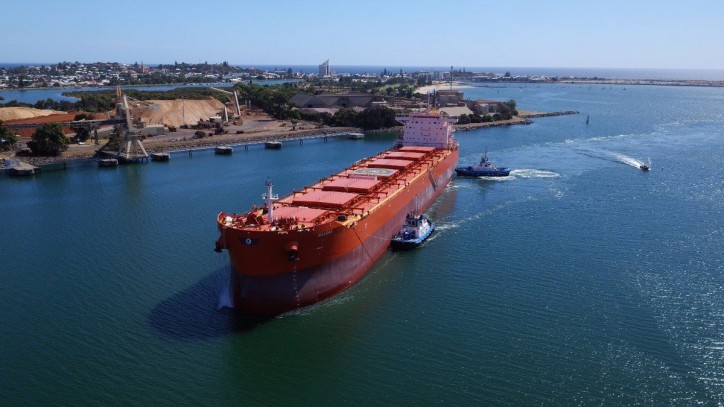Despite continued weak shipping markets Torvald Klaveness maintained a high solidity and good liquidity in 2016. The result was negatively impacted by impairment of container vessels and ended at a loss before tax (EBT) of USD 58 million. Due to a solid cash position after the sale of the five self-unloader vessels in January, Klaveness repaid both bond and bank debt and strengthened cash deposits during 2016. The company took delivery of three vessels in 2016 and has additional four vessels under construction.
The group, consisting of Rederiaksjeselskapet Torvald Klaveness and its subsidiaries, delivered the following consolidated accounts (numbers in USD million):
| Consolidated accounts: | 2016 | 2015 |
| Gross operating revenue | 297 | 400 |
| EBITDA | 44 | 52 |
| Result before tax | -58 | -23 |
| – whereof minority | -8 | 1 |
| – whereof majority | -50 | -24 |
| Total assets | 559 | 723 |
| Equity ratio (incl. minority) | 47% | 43% |
The markets where Torvald Klaveness operates continued to be challenging in 2016. Results for the combination carriers weakened compared to 2015, but were still satisfactory. The container segment was impacted by lower rates and impairments, whilst the results for dry bulk suffered from continued weak markets and low volatility.

Kamsarmax drybulk vessel MV Bavang sold by Torvald Klaveness in December 2016 - Image courtesy of Klaveness
The EBITDA for 2016 was USD 44 million down from USD 52 million in 2015. The combination carriers together with a gain of USD 31 million from the sale of the self-unloader vessels, were the main contributors to the EBITDA. The balance sheet remains solid with a book equity including minority interest of USD 264 million at year-end corresponding to an equity ratio of 47 per cent. High solidity and good liquidity was maintained in 2016. Cash and bank deposits ended at USD 151 million year-end 2016 up from USD 125 million in 2015.
Earnings for the combination carriers weakened in 2016, mainly due to a weaker tanker market, somewhat higher spot exposure and lower transported caustic volumes. Results were nevertheless satisfactory and Klaveness was able to expand its fleet from six to eight vessels by establishing new trades. Additional four combination carriers are under construction, whereof one vessel will be delivered in 2017. EGD Shipholding AS joined as 50 per cent partner in two combination carriers, one delivered in 2016 and one with delivery in 2017.
The container market weakened further in 2016 resulting in an increase in idle days for the Klaveness container vessels, however rates above the general market were still achieved due to the vessels’ fuel efficiency. Impairment of the container fleet amounted to USD 59 million for 2016.
In addition to managing own vessels, Klaveness acts as an operator and manages a portfolio of physical and financial contracts linked to the panamax and supramax dry bulk markets. Klaveness also offers commercial management through pools for external owners in the same segments. As a result of weak dry bulk markets and reduced margins, chartering and trading focused more on industrial type of cargo clients and tailor made services. The total operated dry bulk fleet was 116 and the number of vessels in the Klaveness pools counted 49 vessels at year-end. The dry bulk activities generated a net revenue of USD 11 million in 2016, down from USD 20 million in 2015.
The kamsarmax vessel, Bavang, was delivered from the yard in February. In line with Klaveness’ strategy to focus on building a global combination carrier business, and charter in rather than own standard dry bulk vessels, the vessel was sold in December. After the sale, Klaveness no longer owns any standard dry bulk vessels, but remains a significant operator in the dry bulk market.
Due to a strong cash position after the sale of the self-unloader vessels, Klaveness repaid both bond and bank debt in the fourth quarter. Klaveness also took measures to reduce operating and administration costs further in 2016 and is well positioned to withstand continued low markets.
Klaveness’ vision is to improve the nature of shipping and the strategy focuses on three core areas; establish a global combination carrier service, build the leading digital operator, and provide useful and intuitive digital services. As a result, Klaveness in 2016 has continued to expand the combination carrier concept into new areas, sold the only owned standard dry bulk vessel and has continued to invest in digital initiatives. Digital services have been rolled out to some customers and users in 2016 and Klaveness’ ambition is to expand these services and roll out new services in 2017.
Klaveness’ ship owning activities are organized under the ownership of the subsidiary Klaveness Ship Holding AS. This company is the issuer of the KSH03 bond. Separate consolidated preliminary results for Klaveness Ship Holding have therefore also been published today. In addition to Klaveness Ship Holding, Rederiaksjeselskapet Torvald Klaveness consists of the Chartering and Trading activities and the pool and management companies.
Source: Klaveness